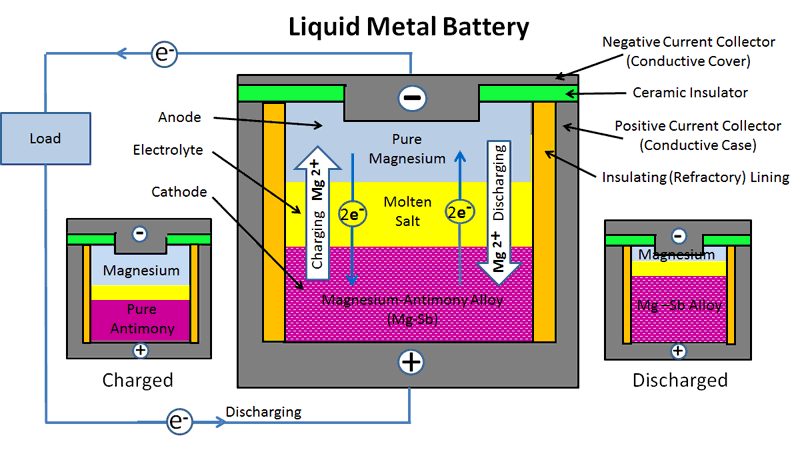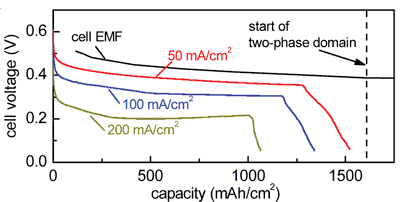Battery and Energy Technologies |
 |
|
Liquid Metal Batteries
Researchers, Professor Donald Sadoway and Dr. David Bradwell, at MIT have produced working prototypes of a revolutionary all liquid metallic battery which produces a current when two dissimilar metals combine to form an alloy. Charging reverses the process reforming the original metals. Since the metals and the electrolyte need to be in liquid form for necessary ion mobility for the reactions to take place, the battery must operate at very high temperatures. This however permits very high current densities, an order of magnitude greater than in conventional batteries, which make the liquid metal battery suitable for electrical power grid applications.
DescriptionThe original development work was carried out using metallic electrodes of magnesium (Mg) and antimony (Sb) with an electrolyte consisting of chlorides of magnesium, sodium and potassium (MgCl2:NaCl:KCl (50:30:20 mol %)). Various alternatives for improving performance or reducing costs have subsequently been investigated, but to simplify the description of how it works the original active components are used here. The following diagram shows the construction and operating principle of the battery. The cell is consists of an insulated container housing the two metals, magnesium and antimony, serarated by the molten salt electrolyte. Because of their different densities and levels of immiscibility, when heated to a liquid form, these three active components do not mix but self-segregate according to their density and float into three distinct layers. The electrolyte can however dissolve both of the metals. There is no need for a separator as used in conventional energy cells.
Operating Principle
Discharging The magnesium is an electron donor and discharge cycle starts with a surfeit of electrons on the negative current collector (the anode) supporting an electric field across the cell between the anode and the positive current collector (the cathode). There is a maximum amount of magnesium in the anode layer and pure antimony in the cathode layer. During discharge, the magnesium anode is consumed as the Mg2+ cations migrate from the upper magnesium layer seeping through the electrolyte to form an Mg-Sb alloy with the antimony in the lower layer increasing its volume. The excess electrons on the anode flow through the external circuit to the cathode where they neutralise the positive charge of the cations. The external current flows in the opposite direction from the electrons, that is, from the cathode (positive terminal) to the anode (negative terminal) delivering power to the load. The electrolyte does not take part in the chemical reaction. The discharge voltage is 0.4 Volts
Charging Power from an external source drives electrons in the opposite direction at the same time pulling magnesium ions from the Mg-Sb alloy and re-depositing metallic magnesium back into the top layer, returning the system to its three distinct liquid layers. When the charging is complete, there remains a voltage differential between the two electrodes providing the electric field which can drive a current through an external load. The charging voltage is 0.55 Volts
Note: The battery does not need an external heat source since the elevated temperature is maintained by self-heating due to the current flow and the chemical reaction. The orignal magnesium - antimony cell chemistry required an operating temperature of around 700°C (about 1300°F) or more but subsequent, alternative cell chemistries have reduced this to around 450°C (842°F).
Cell Performance
The Coulombic efficiency of the original Mg-Sb chemical process is around 98% but taking into account the energy lost in maintaining the high temperature of the cell, the round trip efficiency of this cell chemistry is around 69%.
The low cell voltage means that large numbers of cells will be necessary for the construction of high capacity batteries. This is however mitigated by the high current densities per cell possible with the technology which are about ten times better than conventional cells.
Benefits
Further DevelopmentThough the batteries have been successfully demonstrated in practice, work is still under way to improve performance before they can be deployed commercially. Newer cell chemistries have been introduced to reduce the operating temperature to around 450°C as noted above, this has led to an improvment in round trip efficiency to 75% which is approaching the efficiency of pumped storage systems, but does not require their special geographical locations for its implementation. tHigher voltages have been achieved by replacing the magnesium anode with lithium and lower materials costs as well as lower operating temperatures have been achieved by mixing lead with the antimony cathode. Developments are still ongoing.
ApplicationsThe high current and storage capacities and long cycle life make the liquid metal battery ideal for bulk energy storage on the electric utility grid system for load levelling and for integration of renewable energy from solar and wind power plants.
|
|||||||||||||||||||||||||||||||
![]() Print This Page || Home || FAQ || Site Map || Legal || Privacy Promise || Contacts
Print This Page || Home || FAQ || Site Map || Legal || Privacy Promise || Contacts
Woodbank Communications Ltd, South Crescent Road, Chester, CH4 7AU, (United Kingdom)
Copyright © Woodbank Communications Ltd 2005



